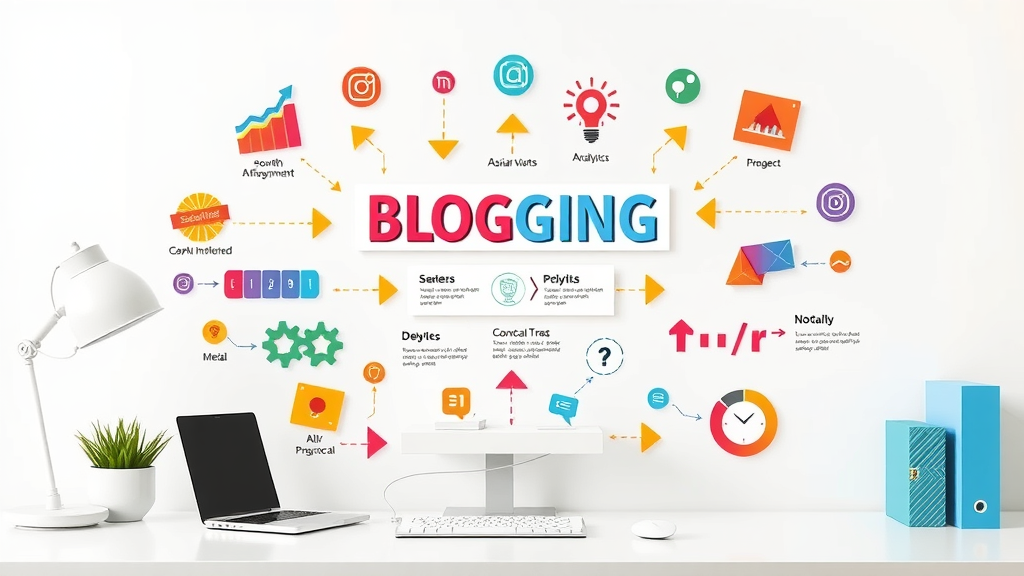Businesses that prioritize content marketing strategies generate over three times as many leads as those who don’t. In a digital world where attention is currency, investing in an effective content strategy can transform your business—delivering genuine ROI, building brand awareness, and positioning your brand as an industry thought leader. Whether you're looking to fine-tune your marketing funnel, become a recognized expert, or increase conversions, discover data-driven approaches and surprising trends that drive unmatched results in today’s market.
Unveiling the Power of Content Marketing Strategies: Surprising Trends and Unmatched Results
Content marketing strategies have shifted from a nice-to-have to an absolute business essential. Companies employing a holistic content marketing strategy not only get noticed by search engines but also gain unparalleled trust among their target audience. In today’s hyper-competitive landscape, successful brands aren’t just creating content—they’re harnessing analytics, multimedia, and distribution tactics that impact real business metrics from lead generation to brand awareness. A well-crafted marketing strategy transforms pain points into opportunities, ensuring every piece of content drives the customer journey forward.
Let’s explore how an actionable plan goes beyond blog posts and taps into the power of social media , video content , and content PR. In the sections ahead, we examine how strategy aligns with business goals, unveils the latest content trends, and highlights industry examples that prove effective content delivers real, measurable results.
Did you know businesses that prioritize content marketing strategies generate over 3 times as many leads as those who don’t? Discover how transformative content strategy can deliver real ROI, foster brand awareness, and set your company on the path to becoming a thought leader.

What You’ll Gain from Adopting Proven Content Marketing Strategies
Embracing proven content marketing strategies opens up a world of growth opportunities for businesses of all sizes. You’ll not only understand what effective content really means in today’s market but also grasp best practices for driving engagement and visibility. With good content strategy , you convert pain points into compelling experiences for your potential customers, build long-term loyalty, and outperform competitors.
You’ll also learn how to craft the perfect content format for every step of the marketing funnel—from blog posts that attract visitors to video content and email marketing that nurture decisions. Explore practical tactics to maximize media content and study real-world examples of brands using content marketing strategy to boost performance. By the end, you’ll be ready to implement actionable ideas that set your organization apart as a thought leader in your field.
Understand effective content marketing and its current best practices
Learn key content strategy principles to maximize visibility and engagement
Explore actionable content marketing tactics for each stage of the marketing funnel
Get inspired by content formats and real-world content marketing success stories
Decoding Content Marketing Strategies: Core Concepts for Success
What Are Content Marketing Strategies? (People Also Ask)
Content marketing strategies are comprehensive plans that guide your brand’s creation, distribution, and measurement of content to achieve specific business objectives. Rather than just creating content for the sake of visibility, the essence of an effective content marketing strategy is to consistently address your target audience’s pain points, cater to their interests, and drive them toward meaningful actions—like email sign-ups or product purchases. Each piece of content is thoughtfully crafted with the marketing funnel in mind, from awareness to conversion.
A strong content strategy ensures that every blog post, video, or social media update aligns with your brand’s values and goals. It enables teams to create content that resonates, provides value, and builds trust. By documenting your process and leveraging analytics, you ensure your content marketing efforts are systematic, scalable, and measurable for sustainable growth.

The 5 C's of Content Marketing Explained (People Also Ask)
A successful content strategy can be remembered by the “5 C’s:” Clarity, Consistency, Creativity, Channel, and Conversion. Clarity ensures your brand’s message and goals are sharp and focused, helping your target audience connect with your offering. Consistency keeps your presence reliable across channels, building recognition and trust over time.
Creativity brings your message to life—whether it’s through a blog post , creative visual, or innovative video content. Channel selection is crucial: Identify where your audience is (social media, email, search engines) and deliver value accordingly. Conversion measures the impact of your content marketing strategies , tracking how well they move potential customers through the marketing funnel toward your business objectives.
Building a Robust Content Strategy: Laying the Foundation for Marketing Success
Crafting an Effective Content Marketing Strategy Blueprint
Building a robust content marketing strategy starts with deliberate planning and a clear understanding of business goals. The process begins with an audit of your current content assets to identify gaps and winning formats. Next, define your target audience personas by analyzing behaviors, pain points, and preferences—ensuring your strategy addresses real needs rather than assumptions.
Translate your findings into a content strategy blueprint that outlines your tone, brand messaging guidelines, distribution channels, and success metrics. This framework will guide your team to create content that’s not just attention-grabbing but aligned with key objectives such as lead generation or thought leadership. Successful content marketing relies on ongoing optimization—so measure, refine, and adapt your strategy to stay ahead of evolving trends.
The 4 Marketing Strategies and Their Role in Content Marketing (People Also Ask)
The four foundational marketing strategies— Product, Price, Place, and Promotion —are the backbone of every effective content marketing approach. Product strategy clarifies the value your content delivers to the end user. Price strategy influences how you convey value and position your content for paid or gated access. Place focuses on distribution: careful selection of channels ensures your content format reaches the right audience.
Promotion ties everything together—leveraging social media, email, and content PR to maximize visibility and brand awareness. In a successful content marketing strategy, these principles translate into content that’s both discoverable (for search engines and humans) and meaningful, fueling your business’s growth engine, from blog posts to interactive videos.

Types of Content that Elevate Your Content Marketing Strategies
A winning content marketing strategy leverages a variety of content formats to address the full spectrum of audience needs. Blog posts deliver authority, fuel SEO, and help you rank higher in search engines . Social media content amplifies engagement and provides a real-time avenue for conversations. Email marketing nurtures existing prospects, turning warm leads into loyal customers.
Video content transforms complex messaging into engaging stories, perfect for platforms like YouTube and LinkedIn. Infographics simplify dense data and statistics, making them easy to digest at a glance. Lastly, interactive media content like quizzes or calculators promotes active participation—capturing valuable insights about your audience while boosting brand awareness and loyalty.
Blog posts for authority and SEO
Social media content for engagement
Email marketing for nurturing leads
Video content for storytelling
Infographics for complex information
Interactive content for audience participation
Video Content: Why It’s Essential to Modern Content Strategies
Today’s digital consumer craves engaging visual stories—and that’s where video content shines. Not only does video make your brand more relatable and memorable, but it also drives higher conversion rates compared to text-only formats. In fact, brands that consistently use video in their content strategies see increased dwell time, stronger social media engagement, and better retention among potential customers.
Effective video content can range from explainer videos and webinars to live Q&A sessions. The key is to create media content that addresses your audience’s pain points, answers pressing questions, and guides viewers through the marketing funnel. Each compelling video acts as both a branding tool and a traffic driver—powering sustainable, measurable growth.

Developing a Content Calendar: Orchestrating Consistent and Effective Content
Consistency is at the heart of every successful content marketing strategy, and nothing helps streamline your efforts like a well-structured content calendar . A content calendar centralizes planning, scheduling, and assignment—helping teams avoid overlooked deadlines and ensuring a steady flow of fresh content across all formats. By mapping out blog posts, social media campaigns, and media content in advance, your business increases productivity and maintains audience engagement.
An effective content calendar also enables you to strategically align content topics with business needs—such as new product launches or seasonal promotions—maximizing your marketing efforts’ impact. You’ll easily spot opportunities to repurpose and distribute content across multiple channels, improving reach without overstretching resources.
Creating a Content Calendar for Effective Content Marketing
To create a high-impact content calendar , start by identifying key themes and events relevant to your brand. Map out your topics by month, including blog posts, video content, and email marketing campaigns. Use color-coding or digital tools for clarity and coordination among team members. Scheduling not only prevents content fatigue but also enhances collaboration and keeps messaging consistent across all channels.
A robust content calendar helps in tracking performance and adjusting topics for maximum effectiveness. Regular audits enable you to see what formats and channels are generating the most traction, giving you valuable insights for future improvements. Ultimately, a strategic calendar ensures that every piece of content serves your target audience while moving your business closer to its marketing goals.

Sample Content Calendar Overview | ||||
Month |
Blog Post Topics |
Social Media Content |
Email Campaigns |
Video Content |
|---|---|---|---|---|
January |
2024 Trend Predictions |
New Year Customer Stories |
Top Product Tips |
Q1 Product Demo |
February |
Case Studies |
Valentine's Day Offers |
Newsletter |
Expert Interview |
Optimizing Content for the Marketing Funnel
A smart content marketing strategy caters to every stage of the marketing funnel —attracting, engaging, and converting your potential customers. Each piece of content should answer where your audience is in their buyer’s journey, from initial awareness (curious visitors) to consideration (comparing solutions) and ultimately, decision (ready to buy). Delivering the right content format at the right stage empowers prospects to move seamlessly through the funnel.
For example, top-of-funnel blog posts generate SEO visibility and answer common pain points. Middle-of-funnel case studies and email marketing deepen engagement by demonstrating authentic value. Bottom-of-funnel assets like testimonials, product demos, and rich video content drive conversions by eliminating buying hesitations.
Mapping Content Formats to Each Marketing Funnel Stage
Effective content marketing means selecting the content formats best suited for your audience’s current mindset. At the awareness stage, informational blog posts, infographics, and engaging social media content raise brand awareness and bring search engine traffic. During consideration, nurture your leads with webinars, email campaigns, and in-depth guides that provide solutions and establish your authority as a thought leader.
At the decision stage, focus on highly persuasive media content—like customer testimonials, free trials, and targeted video content . This content format reassures potential customers, addresses final pain points, and encourages action. Mapping your strategy in this way guarantees the right message reaches the right audience, every time.

Harnessing the Power of Social Media Content
Social media is more than just a distribution channel—it’s a vital feedback loop that supercharges your content strategy . Timely, relevant, and engaging social media content helps brands communicate directly with their audience, gather insights, and shape content based on real interaction. When used strategically, platforms like Instagram, LinkedIn, or TikTok can exponentially increase your reach and foster authentic connection, driving more potential customers into your marketing funnel.
Great social media content goes beyond self-promotion. The most successful brands use media content to tell stories, respond to trending topics, and encourage user-generated content. This not only amplifies brand awareness, but also positions your brand as approachable and trustworthy—key factors in building a loyal community and driving conversions through every stage of the funnel.

Metrics and KPIs: Measuring Effective Content Marketing Performance
To prove the value of your content marketing strategies , you need to track and interpret the right metrics. Key performance indicators (KPIs) like organic traffic, average time on page, bounce rate, click-through rates, and conversions reveal how effective your content really is. Proper analysis highlights which formats and topics resonate with your target audience, while also spotlighting gaps for improvement.
Establishing clear KPIs at the outset gives your team a baseline for evaluating progress, optimizing marketing efforts in real time, and reporting tangible ROI. Don’t just look at vanity metrics—dig deeper into engagement, qualified lead generation, and cost per acquisition to see which marketing tactics are truly supporting business growth.
Tracking Content Marketing Strategy Success
Successful content marketing depends on continuous iteration. Use analytics tools to monitor the performance of every piece of content, from blog posts to video content, in relation to your KPIs. Regularly review metrics by channel and content format—adjust distribution if a particular format performs better on social versus email, for example.
Feedback loops from analytics also help refine future strategy: double down on what works, rework what doesn’t, and keep your content marketing strategy agile. An emphasis on data-driven decisions ensures your marketing efforts are always moving toward meaningful results, maximizing both effectiveness and efficiency.

Content PR and Thought Leadership: Building Authority through Content
Expanding your reach requires more than just publishing your own content. Content PR involves distributing your most valuable assets through earned media placements, guest blogging, and collaborations with influencers or industry publications. This not only introduces your brand to new audiences but also elevates your reputation with search engines and future customers alike.
Thought leadership, meanwhile, is about consistently sharing unique insights and perspectives—positioning yourself as a trusted expert and go-to source in your field. When done right, content PR and thought leadership build deep brand awareness and cultivate long-term trust with both media and potential customers.
Amplifying Brand Awareness with Content PR
Content PR magnifies the impact of your original assets by securing coverage in respected publications and leveraging the influence of industry leaders. This approach opens the doors to backlinks, increased website traffic, and social shares—all of which enhance search engine rankings and brand visibility. By thoughtfully pitching blog posts , infographics, and expert commentary to the right outlets, you reinforce your position as a thought leader and trusted resource.
In addition to spreading your message, successful content PR campaigns can generate positive brand buzz, highlight your expertise, and create opportunities for further collaboration within your niche. For brands seeking to differentiate themselves, investing in content PR is a powerful way to build reputable, scalable authority in any industry.

Case Studies: Content Marketing Strategies That Delivered
Nothing underlines the value of content marketing strategies better than real-world success stories. Leading brands across industries are using unique combinations of blog posts , multimedia content, email marketing, and PR to achieve remarkable results. These case studies illuminate exactly how a creative, well-targeted approach can pay dividends in traffic, conversion, and authority.
Consider Company A, which grew blog traffic by 400% with a laser-focused content strategy . Company B dramatically increased conversions by personalizing email marketing and deploying high-quality media content. Company C combined data-driven infographics and engaging consistent video content to emerge as true thought leaders in their sector—reaping rewards in both business growth and brand reputation.
Company A grew blog traffic by 400% through targeted content strategy
Company B boosted conversions using personalized email marketing and rich media content
Company C established thought leadership with data-driven infographics and consistent video content

Step-by-Step Guide: Implementing Effective Content Marketing Strategies
Ready to translate concepts into action? Follow this practical, step-by-step plan to launch a successful content marketing strategy that sparks sustainable business growth. Start by defining clear goals and KPIs that reveal your marketing efforts’ true impact. Dive deep to understand your audience’s unique pain points, aspirations, and content preferences—ensuring every strategy resonates where it matters most.
Next, audit your existing content to pinpoint strengths, identify gaps, and uncover opportunities for optimization. Develop a personalized content strategy that distinguishes your brand, clearly communicates your value, and addresses the full buyer journey. Create content that’s high-quality, search-optimized, and visually engaging, then publish and distribute it efficiently using your chosen channels. Finally, track results, analyze what’s working, and continually refine your approach for ongoing performance and innovation.
The 7 Steps of Content Marketing for Business Growth (People Also Ask)
Define goals and KPIs
Understand your audience
Audit existing content
Develop a unique content strategy
Create and optimize content
Publish, promote, and distribute
Measure, analyze, and refine
Expert Insights: Maximizing the Impact of Content Marketing Strategies
"Content strategy is not just about creating content, it’s about delivering the right message to the right person at the right time." – Ann Handley
Tips for Crafting Effective Content and Avoiding Common Pitfalls
Building a successful content marketing strategy requires a balance of creativity, consistency, and measurement. Always align content to your business’s larger objectives, focusing on specific audience needs and pain points. Use data and analytics as your compass to refine your strategy and double down on formats that deliver the greatest results. Don’t be afraid to diversify—and remember, great media content includes images, videos, infographics, and interactive elements.
Distribution is as important as creation. Promote your content consistently across platforms your audience uses, and regularly audit your assets to keep everything timely and relevant. By staying proactive, you can anticipate trends and sidestep stagnation, unlocking new opportunities for growth and engagement through every piece of content you share.
Align content to clear business goals
Leverage data to refine content strategy
Diversify content formats
Invest in high-quality media content
Distribute consistently across chosen channels
Regularly audit and update content
Frequently Asked Questions About Content Marketing Strategies
What makes content marketing strategies effective in today’s market? Effective content marketing strategies are tailored to target audience needs, mix diverse content formats, and consistently measure results. They address genuine pain points, use data for decision-making, and are agile enough to adapt to changing trends or technologies, ultimately making your brand more discoverable and trustworthy.
How do I develop a successful content strategy for my niche? Start with audience research to identify your niche’s unique challenges and interests. Craft a tailored content strategy by mapping relevant topics, selecting optimal content formats (like blog posts, video content, or infographics), and choosing channels that your audience already trusts. Consistent optimization ensures ongoing effectiveness.
What content formats should I prioritize for B2B/B2C audiences? For B2B, prioritize whitepapers, case studies, and webinars alongside blog posts to showcase expertise. For B2C, focus on visually engaging formats like video content, social media updates, and user-generated content. Always let your audience’s preferences and behaviors guide your content formats .
How can I repurpose blog posts for email marketing and social media content? Repackage high-performing blog posts into email newsletters, summary infographics, or bite-sized social media content. This amplifies reach, reinforces key messages, and maximizes the value of your original content with minimal extra work.
What role does AI play in modern content marketing strategies? AI streamlines research, optimization, and even creating content by generating insights, personalizing user experiences, and automating parts of the marketing workflow. It helps scale efficient content strategy by identifying what topics resonate and predicting trends.
Key Points to Remember for Your Content Marketing Strategy
Content marketing strategies align with overall marketing strategy and business objectives
Mix of content formats is vital for audience engagement
Consistent measurement and optimization are crucial for ongoing results
Ready to Elevate Your Brand with Innovative Content Marketing Strategies?
Take action to transform your marketing results. Whether you're on Long Island or beyond, start developing your next-level content strategy today. Ready to make waves on Long Island? Let’s chart your course today! Call 631 629 5553
To enhance your understanding of effective content marketing strategies, consider exploring the following resources:
“Go-To Guide for Content Marketing Strategies” : This comprehensive guide outlines six essential steps to build a robust content marketing strategy, including defining objectives, understanding your audience, conducting content audits, planning and creating content, distributing it effectively, and measuring success through analytics. ( victorious.com )
“10 Effective Content Marketing Tactics for 2025 and Beyond” : This article delves into advanced tactics such as encouraging user-generated content and leveraging storytelling to enhance audience engagement and brand authenticity. ( semrush.com )
By integrating these insights, you can develop a content marketing strategy that not only resonates with your target audience but also drives measurable results.
 Add Row
Add Row  Add
Add 




Write A Comment